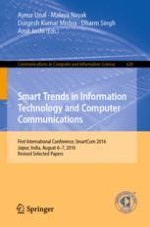2016 | Buch
Smart Trends in Information Technology and Computer Communications
First International Conference, SmartCom 2016, Jaipur, India, August 6–7, 2016, Revised Selected Papers
herausgegeben von: Aynur Unal, Malaya Nayak, Durgesh Kumar Mishra, Dharm Singh, Amit Joshi
Verlag: Springer Nature Singapore
Buchreihe : Communications in Computer and Information Science
